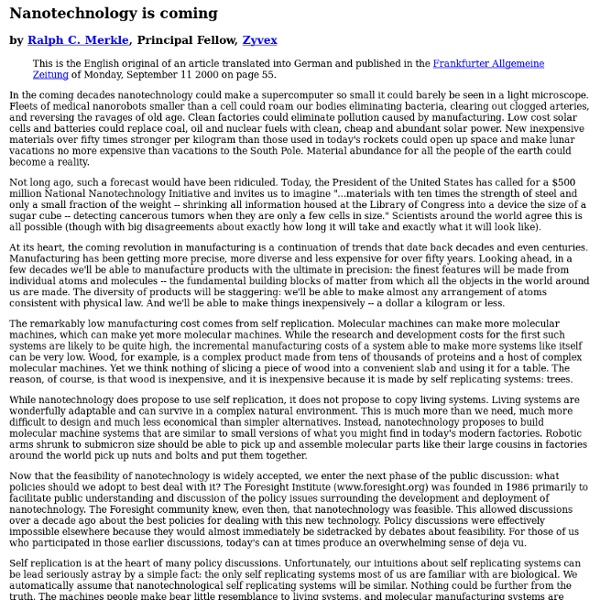Carbon Nanotubes
Transmission electron microscopy of carbon nanotubes: a warning. Carbon nanotube science and technology Carbon nanotubes are molecular-scale tubes of graphitic carbon with outstanding properties. They are among the stiffest and strongest fibres known, and have remarkable electronic properties and many other unique characteristics. For these reasons they have attracted huge academic and industrial interest, with thousands of papers on nanotubes being published every year. The current huge interest in carbon nanotubes is a direct consequence of the synthesis of buckminsterfullerene, C60 , and other fullerenes, in 1985. A transmission electron micrograph of some multiwalled nanotubes is shown in the figure (left). Structure The bonding in carbon nanotubes is sp, with each atom joined to three neighbours, as in graphite. The first two of these, known as “armchair” (top left) and “zig-zag” (middle left) have a high degree of symmetry. The structure of a nanotube can Synthesis Properties Nanohorns
Stellarium
Institute of Nanotechnology
10 Futuristic Materials
Lifeboat Foundation Safeguarding Humanity Skip to content Switch to White Special Report 10 Futuristic Materials by Lifeboat Foundation Scientific Advisory Board member Michael Anissimov. 1. Aerogel protecting crayons from a blowtorch. This tiny block of transparent aerogel is supporting a brick weighing 2.5 kg. Aerogel holds 15 entries in the Guinness Book of Records, more than any other material. Carbon nanotubes are long chains of carbon held together by the strongest bond in all chemistry, the sacred sp2 bond, even stronger than the sp3 bonds that hold together diamond. “Metamaterial” refers to any material that gains its properties from structure rather than composition. We’re starting to lay down thick layers of diamond in CVD machines, hinting towards a future of bulk diamond machinery. Diamonds may be strong, but aggregated diamond nanorods (what I call amorphous fullerene) are stronger. Transparent alumina is three times stronger than steel and transparent. inShare28 Materials
Cyborg snail gets biofuel cell implant
The cyborg snail with a biofuel cell implant that generates electrical power from glucose and oxygen in the snail's blood Earlier this year we reported that researchers had implanted a cockroach with an enzyme-based biofuel cell that could potentially be used to power various sensors, recording devices, or electronics used to control an insect cyborg. While it may not be the most dynamic of creatures, a team from Clarkson University has now performed a similar feat with a living snail. The biofuel cell implanted into the snail by a team led by Evgeny Katz, the Milton Kerker Chaired Professor of Colloid Science at Clarkson University, was able to operate continuously producing electrical power for most of the snail's six month lifespan, using only the snail’s physiologically produced glucose and oxygen in the snail’s blood as a fuel. The team says the implanted biofuel cell would be able to operate in a natural environment, making it suitable for powering various bioelectronics devices.
25 Most Beautiful Animals Photography on StumbleUpon
I think the most beautiful pictures are those made in nature. Nothing compares with the expression of a tiger, the majestic flight of an eagle or the strength of a white bear. Below you can see 25 the most beautiful animal photographs that will capture your attention, and were stumbled on StumbleUpon.
Nanoparticles impact fish through the food chain
A new study shows nanoparticles can harm fish by surviving several links in the food chain. (Photo: iStockphoto) A new Swedish study shows that nanoparticles can survive several links in the food chain. Algae were grown in a tank of water containing nanoparticles. The algae were then fed to animal plankton, and finally the plankton was fed to fish. The behaviour of the fish that consumed these zooplankton changed. The fish simply lost their appetites. Stopped chasing plankton “The fish stopped eating and searching for food,” says researcher Tommy Cedervall, of the University of Lund in Sweden. Researcher Tommy Cedervall (Photo: Lunds University) Scientists found it remarkable that the fish let zooplankton swim in and out of their mouths without even trying to eat them. When placed on a moderate diet, the fish that had been exposed to zooplankton containing nanoparticles didn’t lose weight, according to the article in the journal PLoS One. Hampers metabolism Nanosecurity Lack of regulations
2012 March 12 - The Scale of the Universe Interactive
Discover the cosmos! Each day a different image or photograph of our fascinating universe is featured, along with a brief explanation written by a professional astronomer. 2012 March 12 The Scale of the Universe - Interactive Flash Animation Credit & Copyright: Cary & Michael Huang Explanation: What does the universe look like on small scales? Tomorrow's picture: dust before galaxies Authors & editors: Robert Nemiroff (MTU) & Jerry Bonnell (UMCP)NASA Official: Phillip Newman Specific rights apply.NASA Web Privacy Policy and Important NoticesA service of:ASD at NASA / GSFC& Michigan Tech.
Nanotech greatly reduces leaching in pressure-treated lumber
Pressure-treated lumber has been shown to leach much less preservatives, when treated using a newly-developed technology When people are building things such as decks or fences, they often use lumber that has been pressure-treated with preservatives. While this does indeed help the wood last longer, the chemicals will gradually leach out into the ground, harming organisms within it. Now, however, researchers have found a way of using nanotechnology to keep the preservatives in the wood. The scientists, from Michigan Technological University, encapsulated tiny droplets of the fungicide tebuconazole within spherical nanoparticles. The spheres were chemically modified to work with the fungicide, and were made from either gelatin or chitosan – the latter material is derived from chitin, the main component of the exoskeleton of crustaceans, and has been used in everything from self-healing paint to a flu virus filter to a biocompatible transistor. Source: Michigan Tech About the Author



